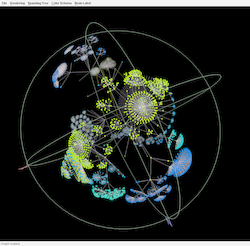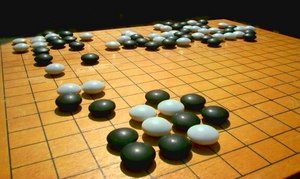January 30, 2005
Lutes' Staff
Sensuelle
January 29, 2005
Throttling Sheep
Back in November I started using the Coral Content Distribution Network to accelerate client downloads of MPG files from the sheep server. It's been working great. Recently Michael Freedman told me that the clients were downloading between 1 and 2 TeraBytes of data per day. Wow. That's 217,000 sheep per day. Since one sheep is born every 6 minutes then that's 240 per day. That means each sheep was downloaded 900 times, which corresponds pretty with the (measured rate of) 1400 unique IP addresses uploading frames per hour. Yea.Times change though: Michael wrote his email to inform me that Coral was instituting a bandwidth cap at 250G per day. Unfortunately a bug in the windows client causes this to prevent it from downloading completely instead of just slowing it down. This is already fixed in v2.6 (not released) but for current users i'm trying to tweek the server as a work-around. It's not working yet but I am working on it.
thank you michael and coral!
January 28, 2005
Walrus
 yummy visualizations of graphs in 3D hyperbolic space by Walrus. Alas the anims do not inspire. No surprise tmm is credited...
yummy visualizations of graphs in 3D hyperbolic space by Walrus. Alas the anims do not inspire. No surprise tmm is credited...
Are you a Shopaholic?
 "You may have affluenza!" That's how my friend Christine greeted holiday shoppers as she handed out flyers on Buy Nothing Day, celebrated each year on the day after Thanksgiving. She got on TV and then the adbusters site.
"You may have affluenza!" That's how my friend Christine greeted holiday shoppers as she handed out flyers on Buy Nothing Day, celebrated each year on the day after Thanksgiving. She got on TV and then the adbusters site.
January 25, 2005
thingster.org
Thingster.org is using a picture of me at Burning Man on their front page. It's the green one in the lower left. Thanks ekai.
FLAM3 v2.3 released
Hairy Font
 A long running project of my friend nick and me is the Hair Font.
We just added images for the letters D, C, H, N, and G.
A long running project of my friend nick and me is the Hair Font.
We just added images for the letters D, C, H, N, and G.
January 24, 2005
Naughty Santa
January 23, 2005
Unamerican Bicycle
Beach Galleries
January 21, 2005
EvoMusArt05
The final version of my paper for EvoMusArt05 is now online, along with additional material and the original data.January 14, 2005
copyright assignment
I just turned in the camera copy for a paper to be published this spring in the EvoWorkshops conference in Switzerland. Part of this process is the little discussed humiliation every academic author goes through: giving up ownership of their words to the publisher. The agreement is below. Not putting my own most polished words on my own website is the most odious term.It is herein agreed that:The copyright to the contribution identified above is transferred to Springer-Verlag Berlin Heidelberg New York (for U.S. government employees: to the extent transferable). The copyright transfer covers the exclusive right to reproduce and distribute the contribution, including reprints, translations, photographic reproductions, microform, electronic form (offline, online), or any other reproductions of similar nature.
The Author may publish his/her contribution on his/her personal Web page provided that he/she creates a link to the above mentioned volume of LNCS at the Springer-Verlag server or to the LNCS series Homepage (URL: http://www.springer.de/comp/lncs/index.html) and that together with this electronic version it is clearly pointed out, by prominently adding "(c) Springer-Verlag", that the copyright for this contribution is held by Springer. From the Publisher's point of view, it would be desirable that the full-text version be made available from the Author's Web page only after a delay of 12 months following the publication of the book, whereas such a delay is not required for the abstract.
The Author may not publish his/her contribution anywhere else without the prior written permission of the publisher unless it has been changed substantially.
The Author warrants that his/her contribution is original, except for such excerpts from copyrighted works as may be included with the permission of the copyright holder and author thereof, that it contains no libelous statements, and does not infringe on any copyright, trademark, patent, statutory right, or propriety right of others.
The Author sings for and accepts responsibility for releasing this material on behalf of any and all coauthors.
In returns for these rights:
The Publisher agrees to publish the identified contribution at his own cost and expense. The Authors are entitled to purchase for their personal use books published by Springer-Verlag with a discount of 33 1/3% off the list price. Resale of such copies is not permitted.
The undersigned hereby gives permission to Springer-Verlag to publish the above contribution to the above book.
January 13, 2005
first used spotworks
an aftermarket has developed. for $14.50 you can get one from gorenfln on amazon. Their comment:I bought this to play at an event. Played only a few times. Practically new.I'm tickled!
SPOTWORKS plugged by Mushroom Magazine
SPOTWORKS in the print edition of Mushroom Magazine:
January 12, 2005
Haeckel on BoingBoing
Haeckel on BoingBoing but no link to my pages. Perhaps the trackback to here will work...January 02, 2005
The Astonishing Game of Go
 From The Economist, an article about the history of my favorite game, Go/Baduk/WeiQi. Just in time for the return of the Go Salon!
From The Economist, an article about the history of my favorite game, Go/Baduk/WeiQi. Just in time for the return of the Go Salon!
The astonishing game of go
THE heavyweight pros on late-night cable television boast nicknames such as Monster, Razor, Butcher, Assassin and Knitting Needle. The most famed matches in history include the Blood Vomiting Game of 1835, the Famous Killing Game of 1926 and the Atomic Bomb Game of 1945. No, this is not some bone-crushing contact sport. It is a simple parlor game where two opponents, comfortably seated and often equipped with nothing more than folding paper fans and cigarettes, take turns placing little stones, some black, some white, on a flat wooden grid. Simple regarding rules and gear, that is, yet so challenging that in this mind-game, unlike chess, and despite the long-standing offer of a $1.6m reward for a winning program, no computer has yet been able to outwit a clever ten-year-old.The game known in English as go—Igo in Japanese, Weiqi in Chinese, Baduk in Korean—is not just more difficult and subtle than chess. It may also be the world's oldest surviving game of pure mental skill. Devised in China at least 2,500 years ago, it had stirred enough interest by the time of the Han dynasty (206BC-220AD) to inspire poets, philosophers and strategic theorists. One of these strategists, Huan Tan (who died in 56AD), advises in his work “Xin Lun”, or “New Treatise”, that the best approach in the game is to “spread your pieces widely so as to encircle the opponent.” Second best is to attack and choke off enemy formations. The worst strategy is to cling to a defense of your own territory—a warning that would have benefited, say, the designers of France's 1930s Maginot line.
Don't expect to stop
Go also had a place in Han-era folklore, in the form of the oft-illustrated story of the woodcutter, Wang Zhi. Wandering in a forest, he is said to have happened upon two sages playing a game. Wang settled down to watch, and became so absorbed that when at last one of the players suggested he should go home, he found that the handle of his axe had rotted entirely away. Returning to his village and recognizing no one, Wang realized he had been gone for a hundred years. A small exaggeration, perhaps, yet the tale says much about the enduring fascination of a game that begins with an empty board and slowly evolves into ever-increasing complexity.Although the roots of chess extend to ancient India and Persia, its present rules were fixed only in the early 19th century. Arabic manuscripts do record, move for move, chess-like games from a thousand years ago, but the oldest fully registered game played by recognizably modern rules took place in Barcelona in 1490. By contrast, the earliest completely recorded game of go, pitting Prince Sun Ce against his general, Lu Fan, and showing tactics almost exactly the same as those used today, is believed to date from 196AD. The 12th-century go manual, “Wang You Qing Le Ji”, or “Collection of the Carefree and Innocent Pastime”, includes dozens of complete, numbered diagrams from actual games that were certainly played during the Tang dynasty (618-907AD), as well as complex puzzles that remain testing for present-day amateurs.
Tang-dynasty fashion ranked proficiency at go as one of the “four accomplishments” necessary for a cultivated gentleman, along with lute-playing, calligraphy and painting. It was during this era that the passion for go, like so much of the high culture of metropolitan China, made its way to such outlying kingdoms as Korea, Tibet and, most infectiously, Japan. Go was all the rage in Japanese courtly circles by the 11th century, as is known from its appearance in Lady Murasaki's great novel of the time, “The Tale of Genji”, in the famous—and again often-illustrated—scene where Prince Genji spies through a screen on two ladies playing the game.
As in China, go in Japan remained for centuries a mere aristocratic pastime, until a sudden flowering under the shoguns of the Edo period (1603-1867). Many of the great warlords of that age being themselves aficionados—in the belief that go provided excellent training for military tactics and strategy—it was not surprising that patronage of the game should have flourished. Four great go schools, all sponsored by the state, were established during the 17th century, as was the ranking system for players that is still used today and the supreme position of Meijin, or go-master to the shogun himself. Meijin Dosaku (who died in 1702), the fourth head of the Honinbo go school, is held by many Japanese to have been the game's greatest player. Although records of only 153 of his matches are preserved, he is said to have achieved the biggest advances in theory since the invention of go.
Proper patronage, professionalization and the rivalry between schools certainly elevated the standard of play in Japan far above that in China. It was in Japan, too, that skill in the manufacture of go equipment reached its peak, in the cutting of perfect boards from the rare, 700-year-old kaya tree, the use of slate for the black pieces and clamshell for the white, and in the fashioning of bowls made of precious mulberry wood to keep them in. Today, a new, top-quality set of this type may cost $150,000.
Not even the end of state go sponsorship that came with the 1868 Meiji revolution—Japan's dramatic opening to the West and its headlong embrace of modernism—was to dent this dominance. By the 1880s, Tokyo newspapers had begun sponsoring go tournaments on a scale that made it possible both to sustain high standards and to maintain a class of full-time professional players. When they ventured abroad before the 1930s, to Japan's new colonies of Taiwan and Korea, and then to Manchuria, or into the warlord-torn Chinese hinterlands, such players felt obliged to handicap themselves by granting native opponents large advantages.
A century of surprises
That has changed. The past century has been the most dramatic in go history. The first surge of excitement came in 1926, when a Japanese pro, Iwamoto Kaoru, discovered a 12-year-old prodigy by the name of Wu Qing Yuan in Beijing. Once word of the boy's skill had reached Japan, invitations were soon forthcoming. By the time he was 19, Mr Wu was beating Japan's top players. Having eliminated all rivals, he won the honor in 1933 of battling the tenth reigning Meijin, Honinbo Shusai, 21st in the line of masters of the great Honinbo school.Mr Wu's opening, a sharp, direct lunge for territory, was seen as shocking, even insulting, to his elder. The ailing Meijin eventually carried the match, but only just, and after shamelessly exploiting his rank to postpone play 13 times, over three months. It was even rumored that his brilliant, tide-turning 160th move had been devised, in breach of strict rules, by one of the Honinbo disciples.
Five years later, Shusai was unseated by a friend of Mr Wu's, in another excruciatingly long match that was to become the subject of an allegorical novel about the decline of old Japan by Yasunari Kawabata, who won the 1968 Nobel prize for literature. Soon after, Mr Wu beat his friend and, over the next 20 years, until he was injured by a motorcycle while crossing a Tokyo street, the Chinese prodigy proceeded to crush every one of Japan's top professionals in an unbroken sequence of victorious ten-game super-matches, known as juban-go.
Mr Wu's game declined after his accident, and he retired from professional play in 1983. Still, at 90 years of age, he has had the pleasure of seeing his own countrymen re-emerge as serious challengers for global ascendance. During the Cultural Revolution, go was demoted from its place among the “four accomplishments” to become one of the four, discarded, “rotten pasts”. Yet in the 1970s a few Chinese players, among them Nie Weiping, who had spent years on a pig farm in internal exile, managed to chalk up individual successes against Japanese opponents. In the 1980s the Chinese began to score team wins with growing frequency, until in 1996 the Japanese cancelled a series of bilateral contests because the results had grown embarrassing.
Significantly, the only two women to reach the rank of nine-dan, roughly equivalent to grand master in chess, are Chinese, and both have emerged within the past 15 years. One of them, Rui Naiwei, is among the world's top 15 players. In 2000 the Iron Lady, as Ms Rui is often called, trounced the world's two top-seeded male players, one after the other in a single tournament.
China's resurgence may not be surprising. Half of the world's 30m or so go players are Chinese, and sponsorship has grown in China, along with general prosperity. China now fields some 300 professional players, compared with 450 in Japan.
The new phenomenon in go is the meteoric rise of South Korea, a country long regarded by its neighbors as a backwater. The first Korean to be noticed internationally was Cho Chik-un. Moving to Japan as a child, he went professional in 1967 at the age of 11. By the time he was 27, Mr Cho held all four top Japanese titles at once. Mr Cho still earns more than any other go player in Japan and, say some, ranks fifth in the world in skill.
Yet Mr Cho's record pales in comparison with South Korea's own Cho Hoon-hyun, currently the world number three. Preferring to stay in his native land, this Mr Cho won a record 16 consecutive Paewan titles, one of South Korea's swankiest, before losing, in 1992, to his own pupil, the current world champion, Lee Chang-ho. Mr Lee, whose legion of Korean fans call him the Stone Buddha, has the distinction of concurrently holding five out of the seven main international men's titles. He is thought to earn nearly $1m a year.
Korea is go-mad. With less than half Japan's population, it has almost three times as many active players. Go schools and clubs clog the halls of apartment buildings in Seoul, a city that supports two full-time go channels on cable television. No surprise, then, that Koreans have taken 41 out of the 54 international cups won since worldwide tournaments, rather than just national ones, were first launched in 1988. That compares with ten for Japan and three for China.
The grandest of all, the $400,000 Ing cup, established by a Taiwanese magnate and contested only once every four years, has never left Korea. The best-of-five games finals for the 2004 Ing cup will take place early in January, pitting Korea's latest bombshell, 19-year-old Choi Cheol-han, against China's 28-year-old Chang Hao. It promises to be a mighty clash, since—as the Chinese proverb says—chess is a battle, but go is war.